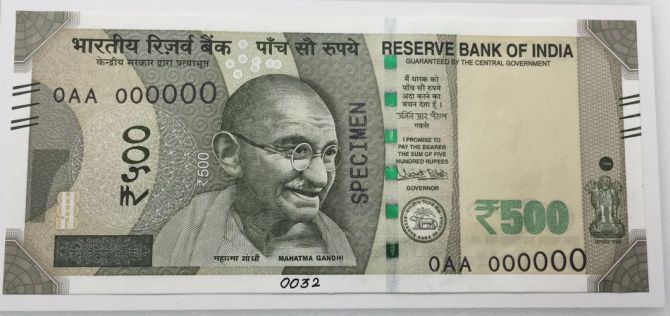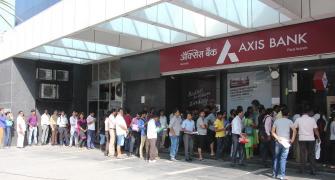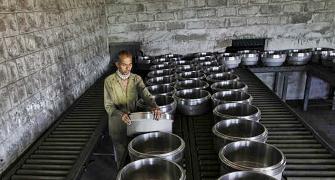A year's print run has been shortened to 5 months, reports Subhomoy Bhattacharjee.
 Strip searches, overlapping Central Industrial Security Force teams manning closed circuit television cameras and stiff integrity checks for employees mark the world's largest operations at India’s four currency presses.
Strip searches, overlapping Central Industrial Security Force teams manning closed circuit television cameras and stiff integrity checks for employees mark the world's largest operations at India’s four currency presses.
No official, irrespective of rank, is allowed to enter -- without a body search -- the compounds at Mysuru, Salboni, Dewas and Nashik where the government is printing suddenly scarce currency notes.
"Even pieces of paper have to be deposited with the security staff. Pockets have to be emptied out at entry and exit," said an official.
For the production staff, the inspection levels are more intense. Security was tightened after the Telgi stamp paper scam, where discarded machine parts were bought by contractors to reprint affidavit sheets with government watermarks.
At the presses, it is the Rs 10 and Rs 100 notes that are printed the most.
Reserve Bank of India data show indents placed in any year for printing smaller denomination notes are 68 per cent of the total print run.
In value terms, the Rs 500 and the Rs 1,000 notes dominate at 86.4%, but the higher demand for smaller notes means the presses spend more time printing these.
Of the four presses, the one at Mysuru has the best printing lines. Till demontisation, this press, along with the one at Salboni, printed the bulk of the Rs 500 and Rs 1,000 notes.
Dewas and Nashik, with older machines, print Rs 100, Rs 50, Rs 20, Rs 10, Rs 5 and Rs 2 notes.
With the import of one machine line in 2015-2016, some of the demand for the Rs 500 note can be met by the Dewas press.
"Our problem is that the rejection rates of notes in the two facilities (Dewas and Nashik) are over 15%. The rates in Mysuru and Salboni hardly ever cross 1%," said an official.
As the government strains to pump cash into the economy, it is this difference that is bothering it.
The RBI's indent for printing of Rs 500 notes is 5.7 billion for the current year and that for Rs 1,000 notes was 2.2 billion. The latter has been scrapped and replaced with a demand for Rs 2,000 notes.
In five months, the automated presses at Mysuru and Salboni, which can run 24 hours without a break, have to print the same number of Rs 2,000 and Rs 500 notes earmarked for the earlier Rs 500 and Rs 1,000 notes over 12 months.
The reason for the scarcity of Rs 500 notes is these two presses were initially making up the shortfall of Rs 2,000 notes. Some of their production lines have now been turned around to print Rs 500 notes.
Also, as the RBI indent data show, the actual demand for pieces of currency notes is not equivalent to their value in circulation. So, the gap can be filled in relatively fast, but not before the middle of the last quarter of this financial year.
Another reason for the shortage of currency notes was the inadequate quality of training for the staff, a source interviewed for this article said.
The presses at Dewas and Nashik are overstaffed, with hardly any effort made over the years to rationalise human resources.
Both plants are old: Nashik came up in 1928 and Dewas in 1975.
At Mysuru and Salboni, under Bharatiya Reserve Bank Note Mudran, which began operations in 1996, huge chunks of the process were automated.
The machinery at Mysuru was supplied by the erstwhile De La Rue Giori, now KBA Giori, Switzerland, and that at Salboni by Komori Corporation, Japan.
The paper for printing high-value notes is imported. Along with a new mill at Mysuru, there is an older mill in Hoshangabad exclusively producing paper for the lower denomination notes.
Order for paper is placed before the beginning of the year because currency paper takes nearly a year to produce. The paper includes a rare cotton blend that is available only in Egypt.
Indian paper mills do not have the fidelity for rolling out such quality of paper even though the mill at Mysuru has improved.
The Mysuru paper mill can, at full steam, produce 6,000 tonnes of currency paper, a third of the annual requirement.
Till some years ago, India produced only five per cent of the paper required for printing its currency notes.
A critical part of the process is insertion of a security thread in the notes. It was here that errors were the highest, said an official.
Because of the risk of forgery, the entire process is conducted in these four high-security printing presses.
Along with that is the production of intaglio ink, which is imported now. But BRBNMPL proposes to set up an ink manufacturing unit, as part of the Make In India programme.










